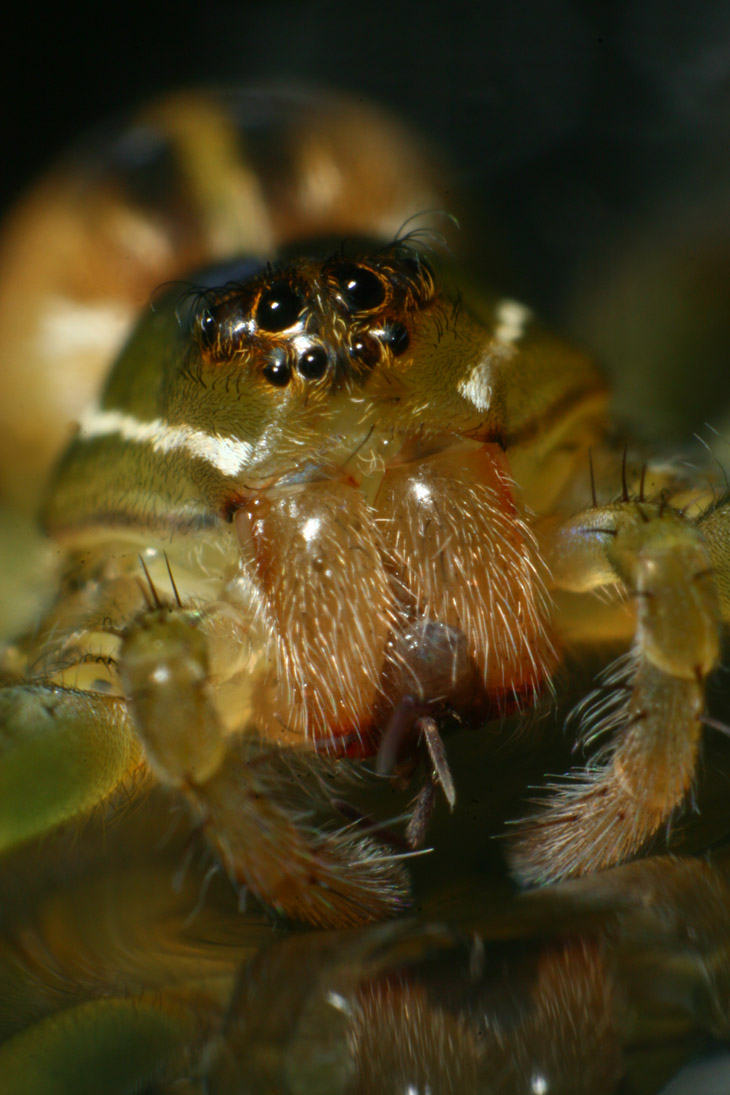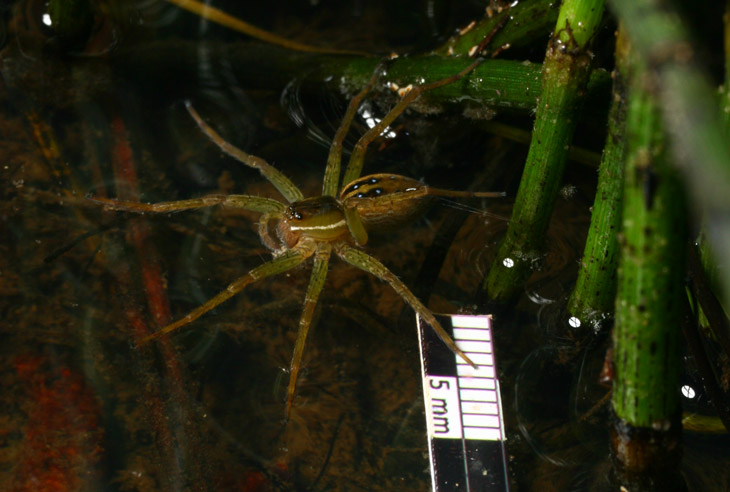
I spent a little time chasing a couple of specific subjects from the backyard pond yesterday, and I’ll be posting about them in detail a little later on, but right now I want to go over this one real quick. Which is not to say this one, as in, the photo above – I’m just using this as a lead in, because I’m going to go even creepier and I wanted the chance to give fair warning. I say this with a certain amount of ironic delight because I know a lot of people can’t be bothered to read the text and are going to blithely scroll down to be greeted by the images unprepared. Serves ’em right. But anyway, the photo above is a mosquito larva, pictured where they spend all but their adult phase, which is under water. I’ve captured a sequence of them emerging before, but am after different, and better, pictures.
Last year, a fishing spider had hung around the pond for a short while before disappearing, likely a victim of the frogs, and I managed to get a few extreme closeups before it vanished. The green frogs overwintered in the pond and I have at least three living within it, but I think the count is more like five or six. For this reason, I wasn’t expecting to see any fishing spiders again, so I was surprised when I found a small one living among the scouring rushes (Equisetum hyemale.) By the way, I had said last year that I had the goal of obtaining some for the pond, and The Girlfriend’s Mother (who I sometimes call my Not-Mother-In-Law) was kind enough to buy me some when she ran across them, so I have a nice pot of them established in the pond now.

This is a juvenile female six-spotted fishing spider (Dolomedes triton,) and if she remains within the scouring rushes she’s relatively well-protected from the frogs. She was consuming a meal when I came across her, and though she gave a few anxious starts and shifts as I leaned in with the camera and flash, she stayed put and I was able to get a few pics. This is a different species from the previous one pictured in that link, and while I think this one averages a little smaller than that one, they both can get impressively big.
As I was pursuing my other subjects with the help of the macro aquarium, I wondered if I could get some nice detail shots of the fishing spider, especially showing the legs on the surface. The challenge was already apparent in my mind: the macro aquarium sat on the porch, and needed to because of the lights and the necessity of a table for steadiness at high magnification, so it would mean capturing the spider and bringing her up to the tank, then convincing her to remain in the tank while I got my photos, and then of course returning her to the pond again. That’s a level of cooperation that’s not warranted in any portion of the animal kingdom, but especially not arthropods, and super-especially not shy spiders. But I figured I’d give it a try.
To my surprise, I coaxed her into a small cup without too much difficulty, where she floated on the surface of the centimeter of water and stayed at the edge, ready to flee if she felt the need, and bobbed there gently as I walked her over to the porch and up the stairs. At the aquarium, I nudged her gently out and she skated across the surface and paused at the edge, still floating, showing no sign of wanting to scale the very low sides and escape across the table. Fishing spiders are more than capable of operating on land, so just having her stay on the water was luck enough.
Even better, as she wasn’t quite facing the way I wanted and the sides were preventing me from shifting position, I gently nudged her with a pipette and was able to redirect her position into a head-on perspective, finding then that she still wasn’t done with her meal (or had obtained another,) several hours after the first pics. This might have had something to do with her docility. Either way, I was able to go in close for a portrait, and we’re well down from my original warning so I take no blame.

Now, I feel the need to mention something – egotistically, if you prefer: this is full frame. This is using the reversed Sigma 28-105 at 28mm, with a 36mm extension tube added, and the full impact of this will hopefully soon become apparent, but for the time being, I would like to point out the curvature of the water under the pressure of the pedipalps, those two little ‘legs’ in front. To the best of my knowledge, they’re just resting on the surface casually, no pressure or support intended, but they’re bending the water down a smidgen.
Now let’s get a scale shot, taken later in the evening after I’d returned her to the pond and then realized I should have something more illustrative for this post.

Her body length was about 9mm, and with leg spread this brought her up to roughly 30mm; a quarter coin measures 24mm if it helps. So when you scroll back up the the portrait shot, you know that the vertical span of her face is maybe 3mm? Yeah – high magnification.
I’m just going to point out the reflections of the softbox attachment in the water at the base of the rushes. nice round spots from a nice round softbox. Much better than rectangular, or even umbrella-shaped.
I credit this session to a lot of luck, with the possibility that her meal(s) made her a little more cooperative; some arthropods seem more likely to sit still while they’re eating. But I have to wonder how much of the success I can credit to having done this a lot. For instance, to capture her I submerged the cup edge in front of her and then gently nudged her from behind, coaxing her ahead, and she just skated across the water surface into the cup. It was almost the same when transferring her into the aquarium, except I couldn’t submerge the cup edge because the aquarium was too narrow, so it was rested against the edge and then tipped until the water was about to spill out, so all she had to do was clamber across the lip. Once in the tank, I settled for gentle nudges on the hind legs to turn and position her, or a simple trick: drawing a thin object (in this case the tip of a pipette) through the water nearby – the turbulence will cause the water to follow and thus anything floating on the surface. I always use small objects and come in low, never overhead, and make the barest of contacts when necessary.
So while there were a lot of things that could have gone awry, there were a lot of things that I could have done wrong too. So I’ll at least take a little credit.



















































